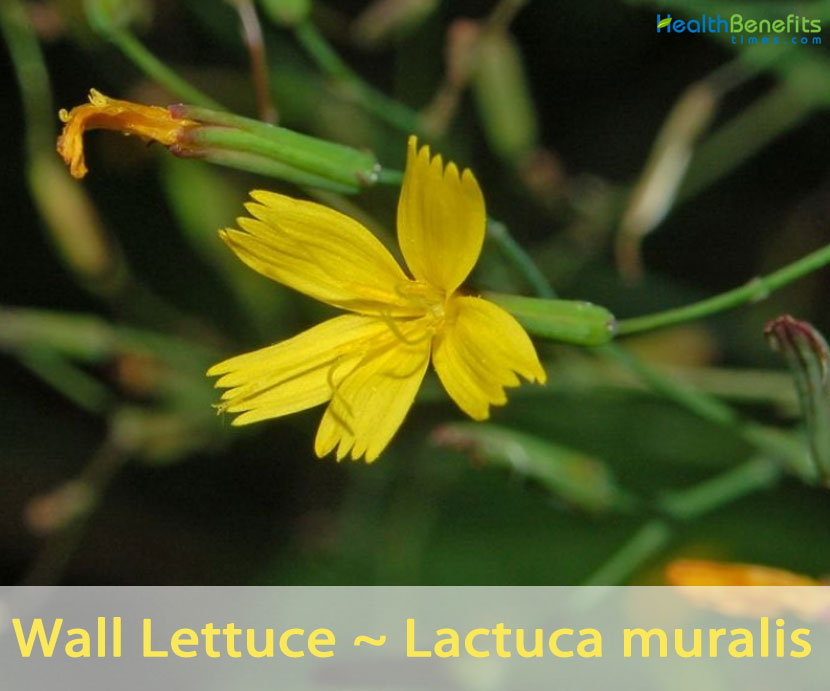| Wall Lettuce Quick Facts | |
|---|---|
| Name: | Wall Lettuce |
| Scientific Name: | Lactuca muralis |
| Origin | Southern Europe and western Asia |
| Colors | Black or brown |
| Shapes | Short beaked, spindle shaped, achene’s that are approximately 0.13 in. (0.33 cm) long |
Wall Lettuce Facts
| Name | Wall Lettuce |
|---|---|
| Scientific Name | Lactuca muralis |
| Native | Southern Europe and western Asia, wall lettuce is invasive in Alaska and the Pacific Northwest. It has been found from eastern Canada south to New York and west to Minnesota. In New England, it is currently mapped in Maine, Massachusetts, New Hampshire, and Vermont |
| Common Names | Wall lettuce, ivy-leaved lettuce |
| Name in Other Languages | Albanian: Micel i murit Armenian: Mits’elis pati (Միցելիս պատի) Bulgarian: Stenna salata (Стенна салата) Catalan: lletuga de bosc, cicèrbita Croatian: Salatika, Šalatika, zidna salatika Czech: Mléčka zední Danish: Skovsalat, Skov-salat Dutch: Muurlatuw, muursla English: Wall lettuce, ivy-leaved lettuce Estonian: Harilik jänesesalat Finnish: Jänönsalaatti, Vuohenkaali French: Laitue des murs, laitue des murailles, mycélis des murs, pendrille, phénope des murailles, phénope des murs German: Mauerlattich, Mauer-Lattich, Mauersalat, zarter Mauerlattich, Gewöhnlicher Mauerlattich Hungarian: Kakicsvirág Irish: Leitís bhalla Italian: Lattuga dei boschi, lattuga Montana Latvian: Mūru mežsalāts Lithuanian: Miškinė zuiksalotė, Zuiksalotė Moldovian: Sosai peduryets mural (Сусай пэдурец мурал) Norwegian: Skogsalat Polish: Salatnik leśny Romanian: Susai pădureț, Сусай пэдурец мурал Russian: lzhelatuk stennoĭ (лжелатук стенной), mitselis stennoĭ (мицелис стенной), molokan stennoĭ (молокан стенной) Serbian: Ajduk-trava, Ajdučica, Ajdučka loćika, Ajdučka trava, Meledina, Hajdučko zelje, ајдучица Slovak: Mliečka múrová, šalátovka múrová Slovenian: Mlejčni osat, Mlenčnica, Mlečni oset, Hajdušica, navadni zajčji lapuh Spanish: Lechuga de los muros, lechuguilla de muro, lechuguina de las peñas Swedish: Skogssallat, Jänönsalaatti Turkish: Divar marulu Ukrainian: Mitselis stinnyy (міцеліс стінний) Welsh: Gwylaeth y fagwyr |
| Plant Growth Habit | Slender, hairless, biennial or perennial, herbaceous, flowering plant |
| Growing Climates | Shady spruce woods and rich mixed swamps, broad-leaved forests on the lower parts of mountains and rocky places, stream valleys, springs, clear-fell areas, beside walls and ruins, parks, gardens, pavements, roadsides, fields, waste lots, walls, rocks, sometimes in beech woods |
| Plant Size | About 25 to 150 cm (10 to 59 in) tall |
| Stem | Erect, 2-3 ft. (0.6-0.9 m) tall, branched above and may one or more stems from a fibrous root. The stem surface is glabrous, often glaucous, and exudes milky juice when broken. |
| Leaf | Lower leaves are lyre-shaped, pinnate shaped. The lobes are triangular in shape, the terminal lobe being the largest. The upper leaves are stalkless, smaller, less lobed and they clasp the stems with rounded toothed lobes. All leaves are red-tinged. |
| Flowering season | July to September |
| Flower | Flower heads are yellow, small, 1 cm (1⁄2 in) wide more or less, on branches 90 degrees to the main stem |
| Fruit Shape & Size | Short beaked, spindle shaped, achene’s that are approximately 0.13 in. (0.33 cm) long |
| Fruit Color | Black or brown |
| Propagation | By Seed |
| Culinary Uses |
|
| Other Facts |
|
Plant Description
Wall Lettuce is a slender, hairless, biennial or perennial, herbaceous, flowering plant that normally grows about 25 to 150 cm (10 to 59 in) tall. The plant is found growing in shady spruce woods and rich mixed swamps, broad-leaved forests on the lower parts of mountains and rocky places, stream valleys, springs, clear-fell areas, beside walls and ruins, parks, gardens, pavements, roadsides, fields, waste lots, walls, rocks, sometimes in beech woods. Stems are erect, 2-3 ft. (0.6-0.9 m) tall, branched above and may one or more stems from a fibrous root. The stem surface is glabrous, often glucose, and exudes milky juice when broken.
Leaves
The lower leaves are lyre-shaped, pinnate shaped about 2.5-7 in. (6.4-17.8 cm) long, 1-3 in. (2.5-7.6 cm) wide, glabrous and deeply lobed, with broad, terminal segments. The lobes are triangular in shape, the terminal lobe being the largest. The upper leaves are stalked less, smaller, less lobed and they clasp the stems with rounded toothed lobes. All leaves are red-tinged.
Flower
The flower heads are yellow, small, 1 cm (1⁄2 in) wide more or less, on branches 90 degrees to the main stem. It flowers from June until September. It has 5 yellow ray florets.
Its main characteristic is an open airy clump of yellow flowers. Each flower is actually a composite flower, consisting of five petal-like flowers (strap or ray flowers), each approximately 5–7 mm (0.20–0.28 in) in length. There are no disc flowers.
Fruit
Fertile flowers are followed by short beaked, spindle shaped, achene’s that are approximately 0.13 in. (0.33 cm) long, several-nerved, and black or brown. The papas have simple white hairs, the inner longer than the outer that may disperse seeds long distances by wind.
Controlling Methods
It’s easy to pull it once you know how to spot it. Wear gloves, since the milky sap can irritate some people’s skin. Pull gently and firmly by the base of the stem and it should pop out; or use a trowel if you need leverage. If the plant has a flower or wispy seed heads, pull them off and put in a plastic bag for disposal; the rest of the plant can be composted, left on the ground to dry, or placed in a black plastic bag or a tarp to prevent re-growth.
References:
https://www.itis.gov/servlet/SingleRpt/SingleRpt?search_topic=TSN&search_value=503893#null
https://pfaf.org/user/Plant.aspx?LatinName=Lactuca+muralis
https://plants.usda.gov/core/profile?symbol=MYMU
https://en.wikipedia.org/wiki/Lactuca_muralis
https://www.invasiveplantatlas.org/subject.html?sub=13084
http://www.theplantlist.org/tpl1.1/record/gcc-116089
https://gd.eppo.int/taxon/MYLMU
https://gobotany.nativeplanttrust.org/species/mycelis/muralis/
https://cisma-suasco.org/invasive/wall-lettuce/
Comments
comments
